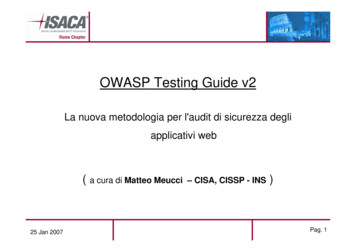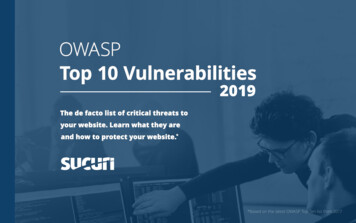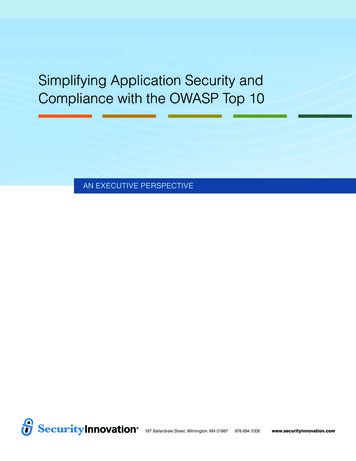
Transcription
OWASP IoT Top 10A gentle introduction and an exploration of root causes
Hi!Nick Johnston (@nickinfosec)Currently: Coordinator, Sheridan College’s Bachelor ofCybersecurityPreviously: Digital forensics, incident response, pentester,developerRecently: Maker stuff, learning electronics
Overview MotivationsIoT Top 10 IntroCase Study Dirty Hack ExperimentFindingsSolutions?Q&A
Won’t be talking aboutManufacturing supply chain attacks (that Bloomberg article)Non-consumer IoT: ICS/SCADA Medical MilitaryImpact of vulnerabilities
CONNECT ALL THE THINGS!
The Cost of Convenience
MotivationsIoT Security Is So Hot Right Now BlackHat 2017 - 8 Talks BlackHat 2018 - 14 Talks BlackHat 2019 - 8 TalksOWASP IoT Top 10 - 2018I like electronics and cybersecurity
Primary Motivation - SecTor 2019Lee Brotherston - “IoT Security: An Insider's ity-an-insiders-perspective/ things in places (aka. The Warehouse Problem)Identity and Access Management (IAM)Low Friction DeploymentSoftware Supply ChainHardware protections are not feasible for consumer IoTRevenue challenges
OWASP IoT Top 10https://www.owasp.org/index.php/OWASP Internet of Things Project
1. Weak, Guessable, or Hardcoded Passwords
1. Weak, Guessable, or Hardcoded PasswordsUse of: Easily bruteforced Publicly available Unchangeable credentialsIncluding backdoors in firmware or client software thatgrants unauthorized access.
2. Insecure Network Services
2. Insecure Network ServicesUnneeded or insecure network services running on thedevice itself, especially: Those exposed to the Internet Any that compromise the confidentiality,integrity/authenticity, or availability of information Any service that allows unauthorized remote control
3. Insecure Ecosystem InterfacesI swear they didn’t pay me toput this in here.
3. Insecure Ecosystem InterfacesInsecure interfaces in theecosystem outside thedevice: WebBackend APICloudMobileCommon issues: Lack of authentication Lack of authorization Lacking or weakencryption Lack of input and outputfiltering
4. Lack of Secure Update MechanismLack of ability to securely update the device. Lack of firmware validation on deviceLack of secure delivery (un-encrypted in transit)Lack of anti-rollback mechanismsLack of notifications of security changes due to updates
4. Lack of Secure Update Mechanism2016 Carnegie Mellon University StudyOn Board Diagnostics: Risks and Vulnerabilities of theConnected Vehicle- Observations: insecure firmware updates anddownloads- Researchers were able to make arbitrary firmwaremodifications and maliciously update ry/asset-view.cfm?assetID 453871
5. Use of Insecure or Outdated ComponentsUse of deprecated or insecure software components/librariesthat could allow the device to be compromised. Insecure customization of operating system platforms Third-party software libraries from a compromised supplychain Third-party hardware components from a compromisedsupply chain
5. Use of Insecure or Outdated ComponentsMeltdownSpectreHeartbleed
6. Insufficient Privacy ProtectionUser’s personal information stored on the device or in theecosystem that is used insecurely, improperly, or withoutpermission.
6. Insufficient Privacy Protection2017 Cornell University StudyA Smart Home is No Castle: Privacy Vulnerabilities ofEncrypted IoT Traffic“we examine four IoT smart home devices [.] and findthat their network traffic rates can reveal potentiallysensitive user interactions even when the traffic isencrypted”https://arxiv.org/abs/1705.06805
7. Insecure Data Transfer and StorageLack of encryption or access control of sensitive dataanywhere within the ecosystem, including at rest, in transit, orduring processing.
7. Insecure Data Transfer and Storage“The Espressif ESP8266 chipset makes three-dollar‘Internet of Things’ development boards an economicreality. According to the popular automaticfirmware-building site nodeMCU-builds, in the last 60 daysthere have been 13,341 custom firmware builds for thatplatform. Of those, only 19% have SSL support, and 10%include the cryptography l-iot-cryptography-on-the-espressif-esp8266/
8. Lack of Device ManagementLack of security support on devices deployed in production,including asset management, update management, securedecommissioning, systems monitoring, and responsecapabilities.
8. Lack of Device ManagementWe haven’t solved this for non-IoT environments yet. 25% still rely on Excel spreadsheets to track assets 56% verify asset location only once a year, while 10-15%verify only every five years Staff spends 10 hours weekly to resolve data accuracyissues Nearly 66% of IT managers have an incomplete record oftheir IT ment-the-key-to-securing-your-enterprise/
9. Insecure Default SettingsDevices or systems shipped with insecure default settings orlack the ability to make the system more secure by restrictingoperators from modifying configurations.
9. Insecure Default SettingsBad filesystem permissionsExposed services running as root
10. Lack of Physical HardeningLack of physical hardening measures, allowing potentialattackers to gain sensitive information that can help in afuture remote attack or take local control of the device.
10. Lack of Physical HardeningEasily Available Debug Port Discovery
The ExperimentWanted to identify potential root causesWanted to simulate: Pressures of getting to market quickly Unfamiliarity with IoT product development process Unfamiliarity with secure development practices
A 24 hour IoT Hackathon
The Background (because we all love a narrative)At the pub afterworkGet website IoTproduct drunkSmart Mirrors!
What is a Smart Mirror?A monitor and a Raspberry Pitaped to the back of aone-way mirror.The Pi updates the displaywith some predetermined infolike date/time, weather, trainschedule, etc.
Other people are making smart mirrors!I NEED to be FIRST for that sweet VC .My friend works for PrimeHuFlix and they gotme a spot TOMORROW on Dragons’ Den SharkTank .
GooseRoost
I get excited and start thinking about marketing.I pick a hip name: brainmirrorI “register a domain”echo “localhost brainmirror.com” /etc/hostsI work memes into your logo
Oh wait.I have to make it firstDesign Requirements CheapNo subscriptionLow friction deploymentEase of use(also it works.hopefully)
The HardwareRaspberry Pi Zero(Anything with WiFi that will run embedded Linux)
The Prototype
IonoitidET
General Solution Structure1.2.3.4.5.6.Pi starts as a wireless access pointConnect to AP and enter local WiFi credentialsDevice redirects to local setup/registration pageRegistration page sent to serverDevice reboots and starts fullscreen mirror applicationDevice queries remote server for data and updates
Technology Stack
Raspbian Setup (Development Setup)Download Raspbian opy the Raspbian image onto an SD card (replace sdX with yours)dd bs 4M if your raspbian image.img of /dev/sdX conv fsyncBoot the Pi and run through the standard Raspbian installerWhen the Pi reboots after installation, open a terminalsudo apt install python3 pip3 flask dnsmasq hostapdShutdown the Pi and image the SD carddd bs 4M if /dev/sdX of dev image.img
Raspbian Setup (Development Setup)Now you can mount the image and edit any files, install the base software, etc.Mounting the development image:sudo fdisk -l dev image.img532480 * 512 272629760sudo mkdir /mnt/pisudo mount -v -o offset 272629760 -t ext4 ./dev image.img /mnt/piCopy application to /mnt/pi/app/brainmirror and edit configs (see later slides).Now you can DD your image onto 100s of SD cards for manufacturing and deployment!
Raspbian Setup (No login boot)(The default is to boot to the desktop without a password promptbut maybe you want to boot to console and start X later? If so.) vim /etc/inittab#1:2345:respawn:/sbin/getty --noclear 38400 tty11:2345:respawn:/bin/login -f pi tty1 /dev/tty1 2 &1:wq sudo shutdown -r now
Raspbian Setup (Startup) sudo vi /etc/rc.localexport FLASK APP wififlask runif wificreds.txt existssudo systemctl disable hostapdsudo systemctl stop hostapdchromium --app file:///app/brainmirror/mirror.html \--start-fullscreen --kioskelse# We’re running a wireless AP (see next few slides)chromium --app file:///app/brainmirror/setup.html \--start-fullscreen --kiosk
Setup.html (this will be displayed on the mirror)
Wireless.html (this will be displayed on user’s phone)
Response
Client Setup - Registration Page
Raspbian Setup (Standalone AP) sudo systemctl stop dnsmasq sudo systemctl stop hostapd sudo vi /etc/dhcpcd.confinterface wlan0static ip address 192.168.4.1/24nohook wpa supplicant:wq sudo mv /etc/dnsmasq.conf /etc/dnsmasq.conf.orig sudo vi /etc/dnsmasq.confinterface wlan0dhcp-range 192.168.4.2,192.168.4.20,255.255.255.0,24h:wq
Raspbian Setup (Standalone AP - cont) sudo vi /etc/hostapd/hostapd.confinterface wlan0driver nl80211ssid BrainMirrorSetupchannel 1:wq sudo vi /etc/default/hostapdDAEMON CONF "/etc/hostapd/hostapd.conf":wq sudo systemctl unmask hostapd sudo systemctl enable hostapd
Server Build (basically) ssh nick@brainmirror.com sudo apt install python3 pip3 redis git git clone brainmirror; cd brainmirror pip3 install -r requirements.txt sudo cp brainmirror.service /etc/systemd/system/ sudo systemctl daemon-reload sudo systemctl start brainmirror
Server-Side Code
Server-Side Code - Device Registration
Mirror Codemirror.html (the important bit)
Server-Side Code - Getting Mirror Data
Server-Side Code - Software Updates
I think I’ve made my point.We’ll just end this before itgets worse.
What went wrong?1.Weak, Guessable, or Hardcoded PasswordsAlso we never changed the default Raspberry Pi user in Raspbian.Why?No idea how to do fancy “first time untrusted connection” protocols. It was easy tojust make a shared key and it helps with “The Warehouse Problem”.Firmware developer unfamiliar with ease of extraction with physical access.
What went wrong?2. Insecure Network ServicesNever disabled SSHNever disabled the local web server on the mirror that was used for setup.Why?Leftovers from development and testingSupport over ssh maybeLow friction deployment and ease of use was a requirement
What went wrong?3. Insecure Ecosystem Interfaces No real authentication or authorizationServed over plaintext httpNo input/output sanitizingLots of opportunity for stored XSS in the config and mirror dataProbably CSRFable?Why? Pace of development, had to make it to market and we went with atechnology stack we knew.Didn’t bother with things like a proper framework, built-in controls or even Let’sEncrypt for encryption.
What went wrong?4. Lack of Secure Update MechanismLet’s look at that update function again.Why? Easy to implement. Solves “The Warehouse Problem” really well.
What went wrong?(Double Jeopardy)6. Insufficient Privacy Protection & 7. Insecure Data Transfer and Storage No HTTPSNo disk encryptionLocation data and name being stored server-side potentially an issueWhy? Maybe unfamiliar with Let’s Encrypt. Possibly holding on to old notions ofcrypto performance (even cheap chips have hardware crypto support to someextent now).Didn’t realize the scope or implications from newer/stricter privacy legislation.
Wouldn’t it have been easy tofix these issues?“Nothing is more permanentthan a temporary solution.”
Root Cause ExaminationPotential common root causes for all the issues I experienced Rapid pace of development to keep up with the marketProduct requirementsLow friction deployment & warehouse problemOutdated training for hardware and software teams
What can we do? Turn-key ecosystems Secure base-OS with support for quick and easy updates(docker?) Libraries and frameworks to solve problems like updates,first-connection trouble, IAM Education and training (IoT Top 10 a good start)
Thanks!Questions?
5. Use of Insecure or Outdated Components Use of deprecated or insecure software components/libraries that could allow the device to be compromised. Insecure customization of operating system platforms Third-party software libraries from a compromised supply chain Third-party hardware components from a compromised supply chain




![REST API Penetration Testing Report for [CLIENT] - UnderDefense](/img/36/anonymised-api-penetration-testing-report.jpg)






